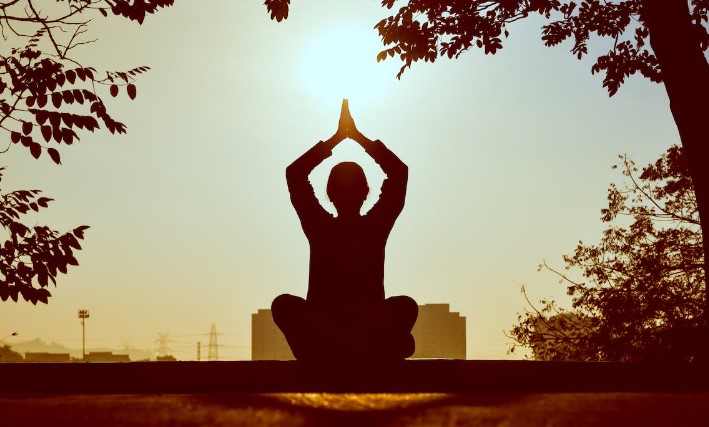Benefits of Yoga: Yoga, an ancient practice originating in India, is becoming more popular in the Western world as people are recognizing the numerous benefits it provides for physical and mental health. The word “yoga” derives from the Sanskrit word “yuj,” meaning to unite, and refers to the concept of uniting the mind, body, and spirit through the practice of physical postures and breathing exercises.
The practice of yoga has evolved over thousands of years and has developed into many different styles and approaches, including Hatha, Vinyasa, Ashtanga, and Bikram. Many people practice yoga for its ability to increase flexibility, strength, and balance, which are essential components of overall health and well-being. In this article, we will explore the benefits of yoga for these three aspects of physical fitness, as well as its overall impact on health and wellness.
Benefits of Yoga for Flexibility
How yoga improves flexibility?
Flexibility is an essential component of physical fitness that enables us to perform daily activities efficiently and without any constraints. The practice of yoga is an effective way to improve flexibility, and it offers a range of benefits that cannot be achieved through conventional stretching exercises.
Specific yoga poses that enhance flexibility
Yoga improves flexibility through the execution of various postures, also known as asanas, that require the extension and contraction of muscles. By performing these poses, the body becomes more supple and able to move with greater ease and fluidity. This increased flexibility also helps to prevent injuries and improves overall athletic performance.
Certain yoga poses are particularly effective in enhancing flexibility, such as the downward-facing dog, warrior 1 and 2, triangle pose, and seated forward bend. These asanas stretch the muscles in the hips, hamstrings, shoulders, and back, increasing their range of motion and reducing the risk of injury. Incorporating these poses regularly into your yoga practice can lead to significant improvements in overall flexibility.
The importance of flexibility in preventing injuries
Flexibility is critical for preventing injuries in physical activities such as running, weightlifting, and other sports. By improving flexibility through yoga practice, the body can better withstand the demands placed on it during these activities. In fact, research has shown that individuals who incorporate yoga into their fitness routines have significantly lower rates of injuries than those who do not.
Moreover, flexibility has a significant impact on our everyday lives. As we age, we tend to lose flexibility, making it harder to perform daily tasks like bending, reaching, and lifting. Practicing yoga regularly can help maintain and even improve flexibility over time, ensuring our bodies remain capable of carrying out essential daily activities.

Benefits of Yoga for Strength
Yoga has numerous benefits, and one of them is building strength. Many people believe that strength-building can only happen through weightlifting or other types of intense exercise. However, several yoga poses can increase muscle strength and overall stamina.
One of the primary ways yoga builds strength is by utilizing body weight as resistance. Yoga postures or asanas work to engage various muscle groups, which become activated once you hold the pose for an extended period. As a result, consistent practice can lead to improved muscle tone and increased strength.
Specific yoga poses that enhance strength include:
1. Plank Pose: Plank Pose strengthens the core, arms, and back muscles. It also improves body alignment and tone.
2. Warrior II: Warrior II pose strengthens the legs and glutes while improving balance and concentration.
3. Crow Pose: Crow Pose strengthens the arms, wrists, and abdominal muscles while boosting confidence and focus.
4. Chaturanga Dandasana: Chaturanga strengthens the arms, shoulders, and core muscles. It also helps to prepare the body for other arm balances.
The benefits of building strength through yoga are as follows:
1. Injury prevention and rehabilitation: Yoga strengthens the muscles and joints, reducing the risk of injury and promoting healing if you have existing injuries.
2. Improved posture and balance: Stronger muscles help to improve overall body alignment, leading to better posture and balance.
3. Increased stamina and endurance: With regular practice, yoga builds strength, endurance, and flexibility, allowing you to sustain physical activities for more extended periods.
4. Stress relief and relaxation: Yoga reduces stress levels and promotes overall relaxation, leading to improved mental and emotional health.
The differences between strength-building in yoga versus weightlifting or other forms of exercise The difference between strength-building in yoga versus weightlifting or other forms of exercise is that yoga focuses on smaller muscle groups while still engaging larger ones. Yoga addresses the whole body rather than concentrating on isolated muscles as weightlifting does. Moreover, yoga combines strength-building with flexibility and balance, leading to a complete mind-body workout experience.
Practicing yoga can build significant strength, improving overall health and well-being. With various poses and styles, yoga is an excellent addition to any fitness routine, promoting strength, flexibility, and balance while taking a holistic approach to physical fitness.
Read About: Importance of Stretching and Flexibility in Fitness
Benefits of Yoga for Balance
Yoga is an ancient practice that promotes physical, mental, and emotional well-being. It has become popular in recent years due to its numerous health benefits, including improving balance. Here are the benefits of practicing yoga for balance.
How yoga improves balance?
Yoga helps improve balance by strengthening the muscles in the feet, ankles, legs, and core. It also improves proprioception or the sense of body position and alignment. Yoga helps train the mind to focus and maintain equilibrium, leading to better balance.
Specific yoga poses that enhance balance
There are several yoga poses that focus on balance and help improve stability. Some of the best poses for balance include:
1) Tree Pose (Vrikshasana) – helps strengthen the legs and improve balance.
2) Warrior III (Virabhadrasana III) – focuses on the legs and core, offering a challenging balance pose.
3) Half Moon (Ardha Chandrasana) – helps strengthen the leg muscles, improve balance, and engage the core muscles.
4) Eagle Pose (Garudasana) – challenges balance and improves concentration.
The importance of balance in daily life and preventing falls
Good balance is essential for daily activities, such as walking, climbing stairs, and getting up from a chair. As we age, our balance tends to deteriorate, increasing the risk of falls, injuries, and fractures. According to the Centers for Disease Control and Prevention (CDC), falls are a leading cause of fatal and non-fatal injuries among older adults. Practicing yoga can help prevent falls by improving balance, increasing flexibility, and strengthening muscles.
How yoga can help people with balance disorders or neurological conditions
Yoga can also benefit people with balance disorders or neurological conditions. For example, Parkinson’s disease can cause balance problems and postural instability. Yoga can help improve balance and reduce the risk of falls in people with Parkinson’s disease. Similarly, people with multiple sclerosis (MS) may experience balance problems due to damage to the nervous system. Yoga can help improve balance, increase flexibility, and reduce symptoms in people with MS.
Other Benefits of Yoga
Yoga has been practiced for thousands of years and has gained immense popularity in recent times. It is an ancient practice that combines physical postures, breathing techniques, and meditation to promote mental and physical health. Yoga has numerous benefits that go beyond just the physical aspect. Here are some other benefits of yoga: Improved Posture
Yoga postures help to strengthen and lengthen the muscles in the body, which in turn aid in improving overall posture. Practicing yoga regularly helps to correct postural imbalances, alignment, and reduces the risk of developing back pain and other posture-related conditions.
Reduced Stress and Anxiety
Stress and anxiety are common problems in modern-day life. Practicing yoga helps to reduce stress, anxiety, and tension by releasing the physical and mental tension stored in the body. Yoga postures, breathing techniques, and meditation are effective tools in managing and reducing stress levels.
Improved Cardiovascular Health
Yoga practice can improve cardiovascular health by reducing blood pressure and heart rate, improving circulation and increasing heart function. Studies have shown that regular yoga practice can help to reduce the risk of cardiovascular disease, stroke, and heart attacks.
Improved Cognitive function
Regular yoga practice is also associated with improved cognitive function, such as memory, attention, and focus. Certain yoga poses, such as inversions, are thought to increase blood flow to the brain, which enhances cognitive function. Meditation is also a powerful tool to improve mental clarity and focus.
Improved Digestion
Yoga can aid in digestion and reduce digestive issues such as constipation, bloating, and gas. Yoga postures stimulate the digestive system, helping to improve the metabolism, and ensure that waste is eliminated effectively.
Improved Immune Function
Yoga helps to boost the immune system by reducing stress levels, improving circulation, and stimulating the lymphatic system. A healthy immune function helps to protect the body from illness and disease.
Types of Yoga
Yoga is a popular physical and mental practice that has been around for over 5,000 years. There are different types of yoga that cater to various body types, goals, and preferences. The following are the most common types of yoga:
1. Hatha Yoga:
This is one of the most traditional forms of yoga and is ideal for beginners. It focuses on basic yoga poses and breathing techniques to help control the mind and body. Hatha yoga classes typically incorporate slow and gentle movements that help improve flexibility, strength, and balance.
2. Vinyasa Yoga:
Vinyasa yoga is a fast-paced type of yoga that focuses on flowing from one pose to another in a series of coordinated movements. It requires more energy and effort than Hatha yoga and is ideal for those who want a more physically challenging work-out.
3. Ashtanga Yoga:
Ashtanga yoga is a dynamic and physically demanding form of yoga that involves a series of poses that are synchronized with deep breathing techniques. This form of yoga requires a lot of physical strength and endurance, making it ideal for those who wish to improve their athletic ability and stamina.
4. Iyengar Yoga:
Iyengar Yoga emphasizes alignment and precision of each posture. Props such as blocks, straps, and blankets are used to help individuals achieve proper alignment and improve flexibility.
5. Bikram Yoga:
Bikram Yoga is a type of hot yoga, where the room is set to a temperature of 105°F. This type of yoga is more focused on achieving postures while sweating and detoxing the body.
6. Restorative Yoga:
Restorative yoga is aimed towards relaxation of the mind and body. It emphasizes healing through breath-work, with various poses designed to improve flexibility and open up different parts of the body.
7. Yin Yoga:
Yin yoga is an ideal practice for those who want to improve their flexibility and overall fitness. Poses are held for a prolonged duration that provides a unique stretch that releases tension in the body.
8. Kundalini Yoga:
Kundalini yoga emphasizes the power of meditation and connecting with energy. It combines various aspects such as chanting, movement, meditation, and breath-work that is designed to increase awareness of the self.

How to Get Started with Yoga?
Getting started with yoga can seem daunting, but with a little bit of research and knowledge, you can find the right path for you. So, here are some essential steps for starting your yoga journey:
Finding a Yoga Studio or Teacher:
Before starting yoga, it is best to find a good teacher or studio. Do some research on your local studios or fitness centers that offer yoga classes. Look at their schedules, instructors’ experience, and reviews from other students. It is also helpful to try out different studios or teachers to get a sense of their teaching style and see if it works for you.
Equipment and Clothing:
Yoga requires minimal equipment. All you need is a yoga mat and comfortable clothing that allows for movement. If you are practicing hot yoga or vinyasa, you may want a towel and a water bottle. Some yoga studios provide mats, but others require you to bring your own. When buying a yoga mat, make sure it is comfortable, durable, and non-slip.
Common Yoga Etiquette:
Every yoga studio has its etiquette norms, but some practices are universal. Be respectful and attentive to others while in class, arrive on time to avoid disrupting others, and turn off your cell phone. Before class, remove your shoes and socks, and leave them outside the studio. Also, it is polite to clean your mat after use.
How to Modify Poses for Beginners or Injuries:
Not everyone can do the poses in the same way, so it is essential to learn how to modify poses. Ask your instructor for modifications due to injuries or if you cannot do a pose. They can guide you to modify the pose to fit your capabilities. Do not push yourself too hard or go beyond your capacity if it hurts or feels uncomfortable. Your body will gradually become more flexible with regular yoga practice.
Conclusion
The practice of yoga has numerous benefits for the body, mind, and spirit. Yogic postures or asanas help to increase flexibility, strength, and balance. By regularly doing yoga, a person can improve their overall physical and mental health. The stretching and bending of the body during yoga help to increase blood flow to the muscles, improve joint mobility, and reduce the risk of injury.
Additionally, yoga can help improve balance which can prevent falls, especially in older adults. The breath work involved in yoga helps calm and relax the mind, reducing stress and anxiety. Furthermore, practicing yoga regularly can boost self-esteem, improve concentration, and reduce feelings of depression. In summary, the benefits of yoga are numerous and can help individuals achieve a healthier, more balanced life.
FAQs
1. How does yoga help improve flexibility?
Yoga involves stretching and holding various postures that target different areas of the body, which can lead to increased flexibility over time.
2. Can yoga build strength?
Yes, yoga is a weight-bearing activity that can help build muscle strength, especially in areas like the core, arms, and legs.
3. Is yoga beneficial for improving balance?
Absolutely! Many yoga postures require balance and stability, which can improve overall balance and reduce the risk of falls.
4. Will practicing yoga make me more flexible, stronger, and balanced all at once?
Yes, yoga focuses on improving all three aspects of fitness simultaneously, which can have a significant impact on overall health and wellness.
5. How long does it take to see improvements in flexibility, strength, and balance from practicing yoga?
This can vary depending on the individual, but many people begin to notice improvements within a few weeks of starting a regular yoga practice.
6. Can yoga help reduce joint pain and stiffness?
Yes, yoga can help improve joint mobility and reduce pain and stiffness, especially when practiced regularly.
7. Is yoga a good choice for older adults or those with mobility limitations?
Yes, many yoga postures can be adapted to accommodate different abilities and limitations, making it a great option for people of all ages and fitness levels.
8. Can yoga help prevent injuries in other physical activities?
Yes, practicing yoga can help improve flexibility, strength, and balance, which can reduce the risk of injury during other physical activities.
9. Are there any risks or downsides to practicing yoga?
As with any physical activity, there is the potential for injury if proper form and technique are not practiced. It is also essential to listen to your body and not push yourself beyond your limits.
10. Can I practice yoga at home, or do I need to attend classes?
While attending classes can be beneficial, there are many resources available for practicing yoga at home, including online classes and instructional videos.

























